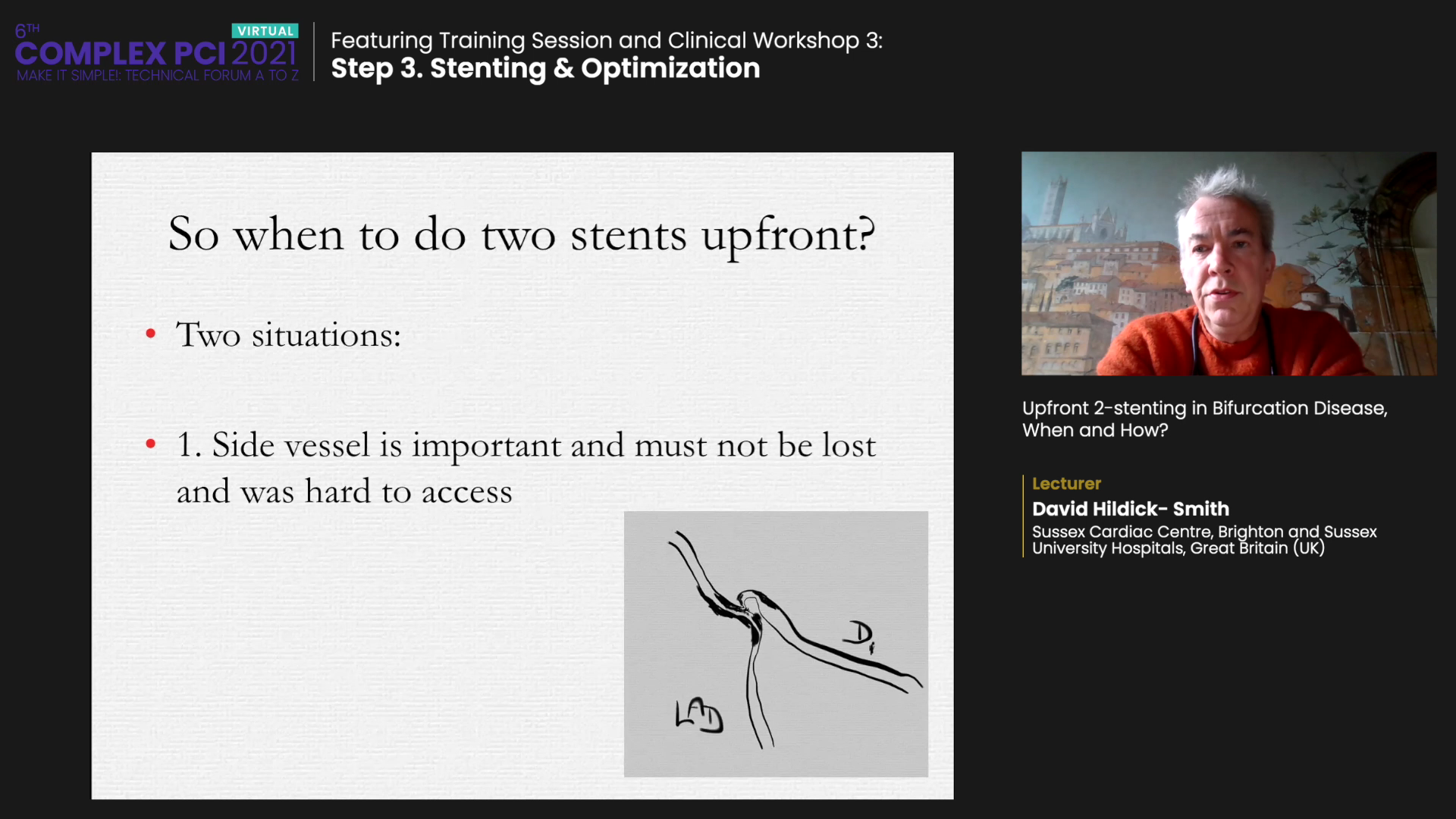Provisional Stenting Simpler, Easier, Faster Than DK Crush But Application Trumps Technique
David Hildick-Smith, MD says not to ĄŪprejudge issueĄŊ and go with stepwise provisional 1-stenting
 Two stents upfront are too much for most left main (LM) bifurcation disease, David Hildick-Smith, MD (Royal Sussex County Hospital, Brighton, UK) said at COMPLEX PCI 2021 on Nov. 25.
Two stents upfront are too much for most left main (LM) bifurcation disease, David Hildick-Smith, MD (Royal Sussex County Hospital, Brighton, UK) said at COMPLEX PCI 2021 on Nov. 25.
Ą°As a strong proponent of the provisional approach, bifurcation lesions should be treated in a sequential, stepwise manner,Ąą Smith said. Ą°Provisional stenting is a logical, planned, systematic approach wherein layers of complexity can be added and stopped upon getting a good result.Ąą
Ą°Ending with two stents during provisional is not a ĄŪcross-overĄŊ or ĄŪbail-outĄŊ: itĄŊs the result of a systematic method that ends with two stents,Ąą he added. Ą°Both provisional and systematic dual-stenting are useful, but the key for complex LM stem bifurcation is to learn a technique and apply its rules rigorously since application is more important than technique.Ąą
Interventional cardiologists remain split over which of the two stenting strategies is best for LM true bifurcation lesions as randomized trials from Chinese and European investigators demonstrated different outcomes.
ItĄŊs implausible that two different but perfectly applied techniques can have materially different clinical outcomes.
The series of DKCRUSH trials by Chinese investigators demonstrated that two stents upfront for percutaneous coronary intervention (PCI) improved composite outcomes of cardiac death, myocardial infarction (MI), target lesion revascularization (TLR), and stent thrombosis.
Results from the DKCRUSH-V trial served as the bedrock for both major American and European guidelines endorsing the upfront two-stent DK Crush technique for left main in 2018.
But growing dissent with the two-stent strategy peaked with the publication of the landmark EBC MAIN trial conducted by Smith and colleagues that championed outcomes with provisional stenting over double stenting.
Ą°We ran EBC Main because, aside from the DK-CRUSH series, most studies including NORDIC, BBC ONE, BBK, and CACTUS showed a lack of benefit with the upfront two-stent strategy for bifurcation. The EBC TWO trial further demonstrated that this lack of benefit extended to those with larger, true bifurcations,Ąą Smith said.
Meta-analysis of the BBC ONE and NORDIC studies favored provisional stenting even where Ą°many operators thought two stents were required,Ąą such as a side branch diameter great than 2.75 mm and a lesion greater than 5 mm.
The EBC MAIN1 trial on 467 patients found no difference between the stepwise provisional approach (n=230) and the systematic dual-stent approach (n=237) at 1-year. Individual secondary endpoints of death MI, TLR, and stent thrombosis showed no difference. Investigators also found a numerical disadvantage in the two-stent arm, Smith said, along with unfavorable procedure time, X-ray dose, and consumables.
Trial outcomes:| Outcomes | Stepwise provisional | Upfront 2-stent | HR (95% CI) |
| Primary composite endpoint | 14.7% | 17.7% | 0.80 (0.5-1.3); p=0.34 |
| Death | 3.0% | 4.2% | 0.70 (0.3-1.9) |
| Myocardial infarction | 10.0% | 10.1% | 0.90 (0.5-1.7) |
| Target-lesion revascularization | 6.1% | 9.3% | 0.60 (0.3-1.2) |
| Stent thrombosis | 1.7% | 1.3% | 0.90 (0.4-1.9) |
The Ą°soberingĄą results also showed that only one in five patients in the stepwise provisional stenting arm needed a second stent, and outcomes between the two arms were similar at 1-year. Ą°These results held even though all operators fully agreed with patient randomization, and so were quite happy to put in two stents according to protocol,Ąą Smith noted.
According to Smith, the outcome differences between DKCRUSH-V and EBC MAIN come down to more extensive disease, higher SYNTAX scores, and operator experience in the DKCRUSH trials. Specifically, operators in DKCRUSH-V had more education, understanding, and training with DK Crush that increased confidence in the technique and resulted in a Ą°philosophy bias.Ąą
On the other hand, European studies had less extensive disease, lower SYNTAX scores, and operators with more experience and confidence in the provisional approach, resulting in a philosophy bias towards the stepwise 1-stenting strategy.
Smith pointed out that the major guidelines recommending DK Crush for bifurcations despite contradicting study results fuels chaos by encouraging inexperienced operators to try DK Crush in left main even though the evidence was drawn from high-volume operators.
Ą°These guidelines are creating complications in Europe because people feel obligated to do DK Crush,Ąą Smith said. Ą°But an optimally done mini-TAP is not going to be clinically inferior to an optimally done mini-DK Crush. Guidelines should not be promoting a specific technique.Ąą
Ą°In the end, provisional or dual-stenting are both applicable for LM stem bifurcation, but the former is simpler, faster, and easier. It uses less contrast and radiation, and you can still put in that second stent if necessary.Ąą
In line with EBC MAIN results, Smith restricted the upfront two-stent strategy to only two occasions. The first Ą°important but infrequentĄą case pertains to when the side vessel is important and canĄŊt be lost but is hard to access. Ą°Once you access a difficult side vessel, the last thing you want to do is jail it. Secure the side vessel with a stent according to your preferred technique, whether it be Culotte, DK Crush, or TAP.Ąą

The second case, which is also quite Ą°rare,Ąą is when the operator is confident that the side vessel needs a stent. But even then, stepwise side branch stenting with provisional is preferred.
Aside from these two rare instances where the concept of Ą°rules are made to be brokenĄą apply, operators should avoid Ą°prejudging the issueĄą and employing two stents upfront, Smith said.
Ą°If the upfront two-stent approach is needed, choose the most familiar technique whether itĄŊs the mini-culotte or the DK Crush because technique shouldnĄŊt matter if you have practice. ItĄŊs not plausible that a perfectly done mini-Culotte and a perfectly done mini-DK Crush can have materially different clinical outcomes.Ąą

